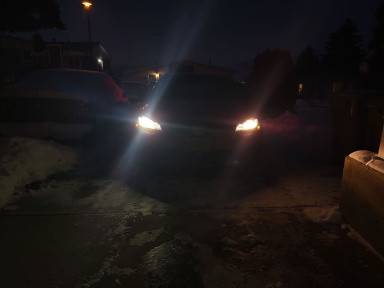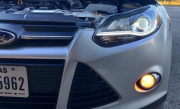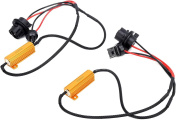
Key Takeaways:
-
Dimming headlights when braking often indicates electrical system problems.
- The vehicle's charging system, which includes the alternator, battery, and voltage regulator, plays a significant role in this issue.
- Prevention and regular maintenance are vital to avoid such problems.
Your headlights are an efficient safety feature when they work properly. However, sometimes, problems occur, such as dimming in certain situations.
Usually, if your headlights suddenly go dim when you hit the brakes, there's something wrong with the electrical system inside your vehicle. I don't want to alarm you, but there are many reasons why this could happen. Tracking down the root of the problem and fixing it can be daunting on your own sometimes.
That's why we've decided to list the most common issues that cause your headlights to go dim when braking. Now, we have all seven lined up to make your road a little bit brighter.

7 Possible Causes of Flickering Headlights While Braking
Whenever you experience problems with the lighting, there's a good chance that your electrical system is suffering from some mysterious issue. Making a connection between cause and effect, between dim headlights and the problem causing them, is difficult if you don't have a proper background.
But we like to keep things simple. Checklists for troubleshooting any possible issues. We like solving problems, and I think you do too. So here you go.
Age
The most basic reason your headlights might go dim sometimes is wear. Some headlights, like LEDs, are designed to last longer. But none can last for many years without fail.
Even contacts within the bulb can deteriorate, which causes dimming when you press the brakes. But how does that really work? When you accelerate, the alternator takes time to catch up and tune down the power it sends to headlights, but when you're braking, the opposite effect occurs.
This drop in power supply, combined with deteriorated components inside the bulb, can lead to dimming when you brake.
If you know that your headlights have been in use for a long time, maybe it's time to check them out or replace them.
Charging System of The Car
The charging system is often responsible for dimming headlights. It has three main components: the alternator, battery, and voltage regulator. Any of them can cause your headlights to dim while braking.
Alternator
Your alternator generates electrical energy to power the vehicle's electrical system and charges the battery. If it malfunctions, it can lead to a series of issues. If the alternator isn't generating enough electricity, your vehicle can only rely on the battery for so long. When the charge is depleted, you may notice your headlights dim during braking.
Regular maintenance and care can prevent this. But if it's too late, consider replacing the alternator.
Voltage Regulator
The voltage regulator ensures that the alternator produces the correct voltage to recharge the battery without overcharging. If it fails, it can lead to power surges or deficits, causing lights to flicker or dim.
Inspect the voltage regulator carefully and replace it if necessary to normalize things.
Weak Battery
Your battery deserves a separate mention. It supplies power to other electrical components in the vehicle, including headlights. When the battery is weak, you might experience a power shortage.
If multiple systems draw power from the battery simultaneously, like when you have the headlights on and you press the brakes, a nearly depleted battery might struggle to supply energy for both. The spike in energy consumption can result in dimming headlights during braking.
A weak battery might lead the vehicle to rely more on the alternator to supply power, causing a temporary power shortage to the headlights.
Every time an electrical component is activated, it draws power. A weak battery may not meet the demand, leading to dimmed headlights.
Signs of a weak car battery include a slow engine crank upon start and a battery warning light on the dashboard. If the battery is 3-5 years old, it might be time to replace it.
Remember, regular battery maintenance is key. Keeping the terminals clean and free from corrosion can help prolong battery life.
Corrosion On The Ground & Wires
Proper flow of power current from the battery to various components is crucial. Even a small amount of corrosion, especially on a ground wire, can cause disruptions. If corrosion is present on the ground or wires, it could lead to headlights dimming when the brakes are pressed.
Corrosion increases electrical resistance. When the brakes are pressed and brake lights activate, this resistance can hinder electricity flow, causing headlights to dim.
Intermittent connections due to corrosion can also cause voltage fluctuations in the system, leading to dimming lights, especially when systems like brakes are activated.
Inspect battery terminals, ground connections, and wiring for corrosion. Clean corroded connections or replace damaged wires for optimal performance.

A Bad Ground Wire
A background wire can spoil your day in multiple ways one of the most noticeable is making your headlights dim when you press the brakes. Every electrical component in a vehicle requires a circuit to function. And the ground wires or critical part that allows for the return of electrical currents.
If a ground wire is not connected properly, gets damaged, or succumbs to corrosion, it can disrupt the flow of electricity within the system. If the ground is compromised, this can divert power away from other systems, like headlights, causing them to dim when the braking system is engaged.
To diagnose this problem, look for flickering lights, sporadic operation of electronic components, or unusual electrical behavior. You can also use a multimeter to check for resistance at ground points and find abnormalities.
The obvious solution is to clean the ground connection. When the grounding point is dirty or corroded cleaning it can restore the proper connection. This can be done using sandpaper or a wire brush to scrub the area, ensuring a metal-to-metal connection.
A loose ground wire can cause a similar issue. Ensuring that all grounding points are tightly secured can prevent problems.
And if you see that it is beyond repair, just replace it. It will restore the optimal performance.
A Worn-out Belt or Tensioner
The serpentine belt and tensioner strongly impact the alternator. The alternator normally relies on the serpentine belt for its operation. When something goes wrong, your battery may suffer.
A worn belt cannot maintain proper tension, and the alternator might not operate at full capacity. So when you press the brakes and the brake lights come on, the supply of power may not be enough for the headlights. This causes the headlights to dim when the brake lights are on.
To identify this problem, listen carefully for a squealing noise during startup or low-speed maneuvers. You can also press on the belt to see if it's still tight.
The best way to fix this problem is through proper maintenance and timely replacement.
Brake Booster
The brake booster is designed to amplify the force applied to the brake pedal, improving the braking performance. It cannot directly cause lights to dim, but it can set some things in motion.
A vacuum leak in the brake booster can cause the engine to work harder to maintain the necessary vacuum levels. This can lead to the lights dimming when braking due to the power deficiency. The same issue can occur if your brakes use an electric vacuum pump.
You can identify problems with the brake booster by a hissing sound made by a vacuum leak, though not necessarily. Another sign is increased resistance from the brake pedal.
When you experience any of these symptoms, check for vacuum leaks and inspect the electric vacuum pump. But don't forget about other components that could have caused it.
Prices for Fixing the Issues
|
Service |
Estimated Cost |
|
Charging system of the car |
$100 - $300 |
|
Corrosion build-up on the ground and wires |
$50 - $150 |
|
A bad ground wire |
$40 - $100 |
|
Weak battery |
$75 - $200 |
|
A worn-out belt or tensioner |
$60 - $250 |
|
Replace the headlights |
$50 - $200 (per pair) |
|
The brake booster may be leaking |
$100 - $400 |
10 Tips to Prevent Dim Headlight
- Make maintenance and checkups your regular habit.
- Clean the headlight covers from dirt and polish them if necessary. UV light and elements can cause damage to the lens.
- Regularly check the battery and connections.
- Upgrade to more efficient headlight bulbs.
- Adjust the headlight aim. If the headlights are not aimed correctly, they might appear dimmer than they actually are.
- Avoid overloading the electrical system with additional accessories.
- Keep track of your headlights' and battery's life expectancy.
- Find some time to check the headlight housing for dirt, rust or build-up.
- Check for damage to wiring or blown fuses on a regular basis.
- Do not neglect to examine the serpentine belt intention from time to time.
Can a Weak Battery Cause Dim Headlights?
While a weak battery can be a reason for dim headlights, especially during the start-up phase, the headlights' overall brightness is more closely tied to the alternator's performance.
You should address battery issues promptly, not only for the sake of the headlights but for the vehicle's overall electrical and operational health. If headlights remain dim while the engine is running, it's wise to check the alternator and other electrical system components.









